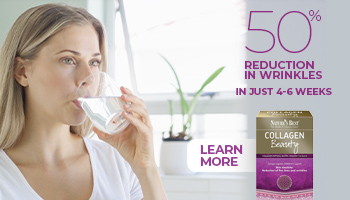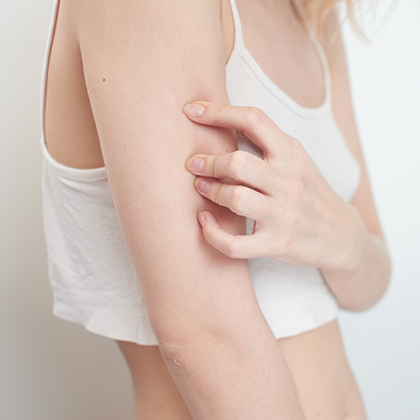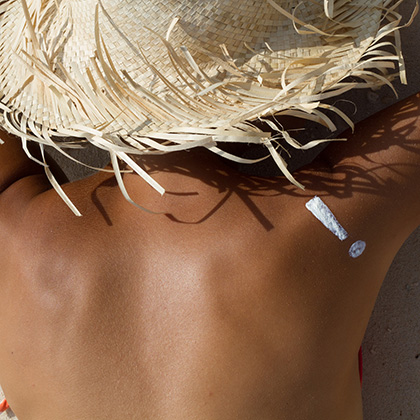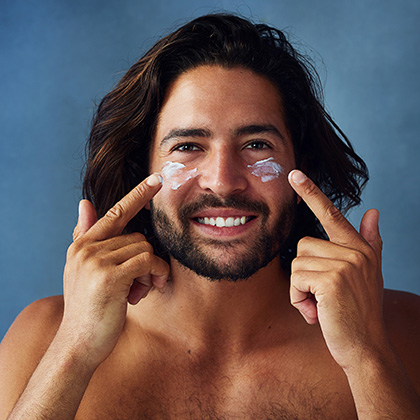
As a nation we’re getting steadily older. According to the Office for National Statistics (ONS) there were 11.8 million people in the UK aged 65 or older in 2016i. And by 2041, this figure is estimated to rise to 20.4 million – which, the ONS experts say, will make up 26 per cent of the country’s total population.
 While our population is getting older, our desire to stay looking as young as possible is stronger than ever. So, it's no surprise that the global anti-ageing skincare market is worth billions, with industry experts forecasting it will reach $66 billion by 2023ii.
While our population is getting older, our desire to stay looking as young as possible is stronger than ever. So, it's no surprise that the global anti-ageing skincare market is worth billions, with industry experts forecasting it will reach $66 billion by 2023ii.
These days, however, you don’t have to be in your later years to start getting concerned about skin ageing. Many well-known skincare brands advise it’s never too early to start using anti-ageing skincare products. Some even encourage young adults in their 20s to consider adopting an anti-ageing skincare regime to tackle the first signs of premature wrinkles.
What happens to our skin as we age?
The skin is the largest organ in the human body and it has many functions besides helping make you look youthful. For instance, besides housing nerve endings that cause sensations such as touch, pain, warmth and cold, your skin helps your body adjust to the outside temperature, with glands in the skin producing sweat to help keep your body cool. Your skin also makes vitamin D when exposed to sunlight and provides your body with a continuous physical barrier.
But as you get older, changes start to happen in the different parts of the skin called the epidermis (the outside layer) and dermis (the inner, thickest layer).
These changes are caused by intrinsic (internal) and extrinsic (external) factors:
-
Intrinsic skin ageing is caused by time passing by, resulting in a reduction in dermal mast cells (immune cells found in the dermis), fibroblasts (cells found in the dermis that are involved in making collagen, elastin and other aspects of the skin’s structure) and collagen production, as well as a flattening of the tissue that joins the dermis to the epidermisiii.
The action of molecules called reactive oxygen species (ROS), which are generated normally by the skin, also plays a part, as ROS – which increase as you get older – destroy skin cell membranes and activate substances that degrade collagen and other proteins that make up the skin’s structure. -
Extrinsic skin ageing is a result of various environmental and lifestyle factors, including smoking, sun exposure, indoor heating, exposure to household chemicals and diet, all of which have been shown to stimulate the production of ROS and skin-damaging molecules called free radicalsiv. The most powerful of these factors is unprotected sun exposure, which is thought to cause more than 80 per cent of facial skin ageing in Caucasiansv.
Ageing and the epidermis
The epidermis has no blood supply, so it relies on its contact with the dermis for its supply of nutrients. But with age, this contact becomes reduced, meaning the epidermis receives a reduced supply of nutrients and oxygenvi. Cell production in the epidermis also slows down as we get older – one study suggests we produce 50 per cent fewer epidermis cells by the time we get to the age of 70vii. As we age we also produce fewer hormones and other chemical signals that are important for skin growth and repairiii.
Ageing and the dermis
The volume and thickness of the dermis decreases with age, and experts suggest the amount of collagen in the dermis drops by one per cent each year throughout adulthoodviii. Collagen fibres also become more fragmented and the quality of the collagen produced with age is of poorer quality than that found in a young person’s skin. The number of blood vessels in the dermis also becomes reduced, leaving the dermis with depleted nutrient levels.
All of these, and many other skin changes that come with age, can cause a number of issues, including wrinkles, sagging skin, fragile skin, pigmentation spots (sun spots) and other skin lesions such as seborrheic keratoses (benign skin growths), not to mention an increase in skin conditions such as eczema, psoriasis and skin itching (pruritus)guide to sun protection//B164Sleep and insomnia//B128). You could also try using silk or satin pillowcases, as these are thought to be kinder to your skin than cotton or polyester ones because they cause less friction.
Can beauty products stop wrinkles?
The anti-ageing market may be worth billions, but can any cream, serum or lotion really help you to stay looking young? Skincare manufacturers would certainly like you to think so, but there’s currently a limited amount of clinical evidence to show that many anti-ageing skincare products actually work.
Anti-ageing products on the market today also contain a wide range of active ingredients, which can make choosing the best product for you a challenge. Knowing your peptides from your alpha-hydroxy acids, however, could be helpful, so here are some of the anti-ageing ingredients you may come across at the beauty counter:
Retinol
Vitamin A compounds called retinoids are widely thought to boost collagen productionii and cell turnover as well as stimulating blood vessels, fading sun spots and softening rough patchesix. You can buy skincare products with retinol over the counter, though stronger retinoid creams are available on prescription from a dermatologists.
Peptides
These are proteins that are thought to help stimulate the growth of new skin cells. However, there are many different peptides used in cosmetics, and studies into their effectiveness are currently few and far between – though one review suggests the evidence to support their use is growingxi. Look for products that contain a mix of different peptides as well as other anti-ageing active ingredients.
Hyaluronic acid
This is a naturally-occurring substance found in the skin that’s also a component of the fluid in your joints as well as your connective tissues. It helps keep your tissues lubricated, but it also draws moisture into the skin, making it suitable for people with skin that has a tendency to be dry. As you get older, you may produce less hyaluronic acid – smoking can have the same effect, as can having a poor diet.
Niacinamide
Also known as vitamin B3, niacinamide is another popular anti-ageing active ingredient that has been shown to produce improvements in fine lines and wrinkles, age spots, skin texture and sallowness xii.
Vitamin C
Antioxidant ingredients such as vitamin C are thought to help reduce collagen degradation in the skin, with one study suggesting a water-soluble form of vitamin C in concentrations of between five and 15 per cent may have an anti-ageing effect by triggering collagen production as well as the production of enzymes thought important for making collagenxiii.
Alpha-hydroxy acids
Along with beta hydroxy acids and poly hydroxy acids, AHAs act as exfoliants, helping to remove the upper layer of dead skin – which is thought to help stimulate the growth of new, and potentially smoother, skin. Found in many products, AHAs include glycolic acid, lactic acid, citric acid and tartaric acid.
However, AHAs can irritate your skin, so look for creams and lotions with lower concentrations (up to 10 per cent) and start by using them just once a week then increase how often you use them very gradually. Higher concentrations are available from dermatologists (these are usually known as chemical peels).
Nutritional skin savers
Topical anti-ageing products have a place in any anti-ageing beauty regime, but what you put in your body may also help make a difference to the texture, quality and general health of your skin. Some of the nutritional supplements recommended by natural health practitioners include the following:
Anthocyanidins
Belonging to a group of antioxidants called flavonoids, anthocyanidins are found in the skin of dark and richly coloured fruit such as blueberries, blackberries, raspberries and red grapes, as well as in pine bark (pycnogenol) and grape seed extract. They may be useful for skin ageing as one study found they may protect against the damaging effects of UV lightxiv
Biotin
A member of the B vitamin family, biotin is needed to help maintain the skin, with studies suggesting that biotin deficiency may cause a range of skin problemsxv. Good sources of biotin include liver, eggs, salmon, cheese, avocado, cauliflower, whole grain bread and raspberries – though you can also get it as a nutritional supplement, either on its own or as part of a vitamin B complex supplement.
Silica
The second most abundant element on Earth, silica is thought to be important for the body’s production of collagen, making it a key nutrient for skin strength and elasticityxvi. Good dietary sources of silica include oats, barley and rice – though refining processes can strip much of the silica away from these and other grains. Silica supplements are often derived from the herbs nettle or horsetail, but those derived from bamboo gum are thought to have a far higher silica content.
High-strength fish oils
The omega-3 fatty acids found in oily fish such as salmon, sardines and mackerel are arguably best known for their potential effect on heart health, with experts recommending that you eat at least two servings of oily fish a weekxvii. However, experts also recommend omega-3s for younger-looking skin – for instance, in his book The Wrinkle Cure, dermatologist and skincare expert Dr Nicholas Perricone suggests foods rich in omega-3s help reduce the production of inflammatory compounds in the body that are involved in ageing, specifically ageing of the skinxviii.
Meanwhile a review published by University of Manchester experts suggests omega-3 fatty acids may help protect skin against sun damage, which is widely believed to accelerate skin ageingxvix.
If you are a vegetarian or vegan, you can still benefit from an omega-3 supplement, thanks to the availability of products that contain the natural triglyceride (TG) form of omega-3, which is sourced from plant organisms called microalgae rather than fish.
Sea buckthorn berry oil
The orange berries of the sea buckthorn shrub contain a range of nutrients thought to be useful for the skin, particularly dry and ageing skin, with its mix of omega-6, omega-7 and omega-9 fatty acids thought to be important for the regeneration and repair of the skinxx. As well as taking sea buckthorn berry oil supplements, you could try applying the oil directly to your skin, since the oil is thought to penetrate the epidermis easilyxx.
Vitamin C
This valuable skin nutrient is often found in skincare products – particularly those designed to tackle the signs of ageing – but it may also give skin a boost if you take it as a nutritional supplement. Your skin contains high concentrations of vitamin C naturally, which your skin needs for the production of collagen and – thanks to vitamin C’s antioxidant action – to help protect against sun-induced ageing. Indeed, one review published in the journal Nutrients suggests a number of studies support the idea that vitamin C can improve the signs of ageing in human skinxxi.
Zinc
Zinc is also found naturally in the body, with around five per cent of it found in the skinxxii. It may be useful for skin health because of its antioxidant properties, with experts suggesting it may help prevent sun damage (xxiii), which is linked with premature skin ageing. You can find zinc in foods such as shellfish, red meat, lentils, beans, eggs, whole grains and dairy foods, but it’s also widely available in supplement form.
Beta carotene
A red-orange pigment found in plant foods, beta carotene is converted into vitamin A – a nutrient needed for healthy skin – in the body. It’s also an antioxidant and belongs to the carotenoid family of plant pigments. Some researchers believe that carotenoids such as beta carotene may help protect skin against sun damagexxiv. Another carotenoid called lutein may also have sun-protective capabilities, with researchers finding it may improve skin tone and elasticityxxv.
Green tea
Green tea is a popular drink these days, accounting for 20 per cent of global tea consumptionxxvi. But there are many nutrients in green tea that have been studied for their effects on human health, including how it may help with skin health. Some researchers believe antioxidants found in green tea called green tea polyphenols may help protect skin against sun-related ageing as well as skin cancerxxvii. Green tea is also available in supplement form for those who don’t like the taste.
High-strength multivitamin and mineral
Last but by no means least, a good-quality multivitamin and mineral can provide a wide range of the nutrients your skin needs at any age. Some also provide extra skin-boosting nutrients such as green tea and lutein.
References:
-
Office for National Statistics. Living longer: how our population is changing and why it matters. Available online: https://www.ons.gov.uk/peoplepopulationandcommunity/birthsdeathsandmarriages/ageing/articles/livinglongerhowourpopulationischangingandwhyitmatters/2018-08-13#how-is-the-uk-population-changing
-
Available online: statista.com/statistics/509679.value-of-the-global-anti-aging-market/
-
Nigam. Y., Knight. J. (2017). Anatomy and physiology of ageing 11: the skin. Nursing Times. 113: 12, 51-55. Available online: https://www.nursingtimes.net/roles/older-people-nurses/anatomy-and-physiology-of-ageing-11-the-skin/7022248.article
-
Valacchi. G., et al. Cutaneous responses to environmental stressors. Ann N Y Acad Sci. (2012 Oct). 1271(1): 75–81. Available online: https://www.ncbi.nlm.nih.gov/pmc/articles/PMC3495295
-
Flament. F., et al. Effect of the sun on visible clinical signs of aging in Caucasian skin. Clin Cosmet Investig Dermatol. (2013 Sep). 27;6:221-321. Available online: https://www.ncbi.nlm.nih.gov/pubmed/24101874
-
Tobin. D.J. Introduction to skin aging. Journal of Tissue Viability. (2017). 26: 1, 37-46. Available online: https://www.ncbi.nlm.nih.gov/pubmed/27020864
-
Cerimele. D., et al. Physiological changes in ageing skin. British Journal of Dermatology. (1990). 22 (Suppl 35): 13-20. Available online: ncbi.nlm.nih.gov/pubmed/2186780
-
Rigel. D.S., et al. Photoaging. (2004). Boca Raton, FL: CRC Press. ISBN 13: 9780824754501.
-
Varani. J., et al. Vitamin A antagonizes decreased cell growth and elevated collagen-degrading matrix metalloproteinases and stimulates collagen accumulation in naturally aged human skin. J Invest Dermatol. (2000 Mar). 114(3):480-6. Available online: https://www.ncbi.nlm.nih.gov/pubmed/10692106
-
Do retinoids really reduce wrinkles? Harvard Health Publishing . Available online: https://www.health.harvard.edu/staying-healthy/do-retinoids-really-reduce-wrinkles
-
Lupo. M.P., Cole. A.L.. Cosmecutical peptides. Dermatol Ther. (2007 Sep-Oct). 20(5):343-9. Available online: https://www.ncbi.nlm.nih.gov/pubmed/18045359
-
Bissett. D.L., et al. Topical niacinamide reduces yellowing, wrinkling, red blotchiness, and hyperpigmented spots in aging facial skin. Int J Cosmet Sci. (2004 Oct). 26(5):231-8. Available online: https://www.ncbi.nlm.nih.gov/pubmed/18492135
-
Nusgens. B.V., et al. Topically applied vitamin C enhances the mRNA level of collagens I and III, their processing enzymes and tissue inhibitor of matrix metalloproteinase 1 in the human dermis. J Invest Dermatol. (2001 Jun). 116(6):853-9. Available online: https://www.ncbi.nlm.nih.gov/pubmed/11407971
-
Saliou. C., Rimbach. G., et al. Solar ultraviolet-induced erythema in human skin and nucelar factor-kappa-B-dependent gene expression in keratinocytes are modulated by a French maritime pine bark extract. Free Radic Biol Med. (2001 Jan 15). 30(2):154-60. Available online: https://www.ncbi.nlm.nih.gov/pubmed/11163532
-
Mock. D.M. Skin manifestations of biotin deficiency. Semin Dermatol. (1991 Dec). 10(4):296-302. Available online: https://www.ncbi.nlm.nih.gov/pubmed/1764357
Gupta. A.K., Bluhm. R. Seborrheic dermatitis. Seborrheic dermatitis J Eur Acad Dermatol Venereol. (2004 Jan). 18(1):13-26; quiz 19-20. Available online: https://www.ncbi.nlm.nih.gov/pubmed/14678527 -
de Araujo. L.A., et al. Use of silicon for skin and hair care: an approach of chemical forms available and efficacyt. An Bras Dermatol. (2016 May-Jun). 91(3): 331–335. Available online: https://www.ncbi.nlm.nih.gov/pmc/articles/PMC4938278
-
Bowen. K.J., et al. Omega-3 Fatty Acids and Cardiovascular Disease: Are There Benefits? Curr Treat Options Cardiovasc Med. (2016). 8(11): 69. Available online: https://www.ncbi.nlm.nih.gov/pmc/articles/PMC5067287
-
Perricone. N. The Wrinkle Cure. Curr Treat Options Cardiovasc Med. ISBN-13:9780446677769. Available online: https://www.hachettebookgroup.com/titles/nicholas-perricone/the-wrinkle-cure/9780446677769
-
Pilkington. S.M., et al. Omega-3 polyunsaturated fatty acids: photoprotective macronutrients. Exp Dermatol. (2011 Jul). 20(7):537-43. Available online: https://www.ncbi.nlm.nih.gov/pubmed/21569104
-
Zielinska. A., Nowak. I. Abundance of active ingredients in sea-buckthorn oil. Lipids Health Dis. (2017). 16: 95. Available online: https://www.ncbi.nlm.nih.gov/pmc/articles/PMC5438513
-
Pullar. J.M., et al. The Roles of Vitamin C in Skin Health. Nutrients. (2017 Aug). 9(8): 866. Available online: https://www.ncbi.nlm.nih.gov/pmc/articles/PMC5579659
-
Ogawa. Y., et al. Zinc and Skin Disorders Nutrients. (2018 Feb). 10(2): 199. Available online: https://www.ncbi.nlm.nih.gov/pmc/articles/PMC5852775
-
Gupta. M., et al. Zinc Therapy in Dermatology: A Review. Dermatol Res Pract. (2014). 709152. Available online: https://www.ncbi.nlm.nih.gov/pmc/articles/PMC4120804
-
Shagen. S.K., et al. Discovering the link between nutrition and skin aging. Dermatoendocrinol. (2012 Jul 1). 4(3): 298–307.
-
Juturu. V., Bowman. J.P., Deshpande. J. Overall skin tone and skin-lightening-improving effects with oral supplementation of lutein and zeaxanthin isomers: a double-blind, placebo-controlled clinical trial. Clin Cosmet Investig Dermatol. (2016). 9: 325–332. https://www.ncbi.nlm.nih.gov/pmc/articles/PMC5063591
-
Available online: o-cha.net/english/teacha/distribution/greentea3.html
-
Zink. A., Traidl-Hoffman. C. Green tea in dermatology – myths and facts. J Dtsch Dermatol Ges. (2015 Aug). 13(8):768-75. https://onlinelibrary.wiley.com/doi/full/10.1111/ddg.12737
Disclaimer: The information presented by Nature's Best is for informational purposes only. It is based on scientific studies (human, animal, or in vitro), clinical experience, or traditional usage as cited in each article. The results reported may not necessarily occur in all individuals. Self-treatment is not recommended for life-threatening conditions that require medical treatment under a doctor's care. For many of the conditions discussed, treatment with prescription or over the counter medication is also available. Consult your doctor, practitioner, and/or pharmacist for any health problem and before using any supplements or before making any changes in prescribed medications.
Related Posts

Christine
Christine Morgan has been a freelance health and wellbeing journalist for almost 20 years, having written for numerous publications including the Daily Mirror, S Magazine, Top Sante, Healthy, Woman & Home, Zest, Allergy, Healthy Times and Pregnancy & Birth; she has also edited several titles such as Women’ Health, Shine’s Real Health & Beauty and All About Health.
View More



